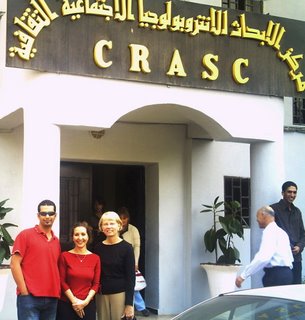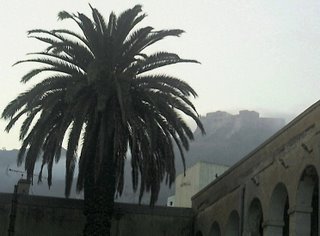Fun in Oran
 Oran’s Heritage
Oran’s HeritageI arrived in Oran, while a colloquium was taking place at CRASC (Centre de la Recherche en Anthropologie Sociale et Culturelle) on Mediterranean Inheritances and Identities. Therefore, I was invited to a buffet dinner, Saturday evening (October 28), on by birthday–what luck, as well as to lunch and a tour of the city the next day. The fish soup at the luncheon was delicious. The tour was supposed to be of the old city; but we actually saw more of the new city (Place of 1st November, with its pillar in tribute to Amir Abdelkader, the Opera House, and the Hotel de Ville–bronze lions out-front), the city wall built by the Spanish, the neo-Moorish style train station, an indoor (covered) market, the corniche along the water front, and other squares and popular quarters of the city. The exterior of a synagogue remains, although it has been converted into a mosque. The country’s Jewish population, along with the pieds noirs (French colonial settlers), left with independence in 1962.
The reason we didn’t see many of the old buildings is that, for the most part, they are in a state of disrepair due to governmental neglect. In the old city, we drove by a former Prefecture building (French colonial style) and spent a lot of time visiting a foundation dedicated to Sidi El Houari. His tomb and sanctuary itself, very popular with Algerians, we could only see through an alleyway, as we drove by on a nearby street. Algerians are still very sensitive about their religious beliefs; we couldn’t visit. The foundation itself consists of recovered Turkish baths and a French colonial hospital, which young people are restoring to provide educational facilities and a community center for Oran. We also didn’t see the Mosque of the Pasha, or the Palace of the Dey, or Spanish Door. Some apartment buildings in the district have collapsed. A church near the Sidi El Houari Foundation and overlooking the port, the Cathedral of Saint Louis, is in bad condition. Through some exploration we were able to enter. First, light shone through a rusted metal door, so we tried to enter here. This eventually turned out to be the entry to a side chapel, where the members of the guardian’s family had made their sparsely furnished home. It was partitioned off from the rest of the structure with reused doors and boards.
 After much pounding, we tried another entrance a few feet to the right, which finally led into the building. The guardian was absent. His wife, three children, and another older woman were present. They seemed shocked and startled that someone would want to visit their dwelling place on a Sunday evening. Paint is peeling from the walls; the infrastructure is slowly crumbling. I looked up into the nave and vaulted walls, feeling a sense of awe at the sheer size of the structure. On the way out light shines through the shapes of a window, which might, at one time, have been filled with stained glass. Today, only reflected light from their empty spaces reflects on the nearby wall. Nothing of any value, and almost literally nothing else, remains in the church. As we were leaving, the wife, clothed in long pink bathrobe and scarf, wound around and tied don the top of her head (Berber style), seemed to be assuring the youngest child, a little girl, that things could finally now calm down again.
After much pounding, we tried another entrance a few feet to the right, which finally led into the building. The guardian was absent. His wife, three children, and another older woman were present. They seemed shocked and startled that someone would want to visit their dwelling place on a Sunday evening. Paint is peeling from the walls; the infrastructure is slowly crumbling. I looked up into the nave and vaulted walls, feeling a sense of awe at the sheer size of the structure. On the way out light shines through the shapes of a window, which might, at one time, have been filled with stained glass. Today, only reflected light from their empty spaces reflects on the nearby wall. Nothing of any value, and almost literally nothing else, remains in the church. As we were leaving, the wife, clothed in long pink bathrobe and scarf, wound around and tied don the top of her head (Berber style), seemed to be assuring the youngest child, a little girl, that things could finally now calm down again.I thought about where Algeria is today and where it might be going. What vision do Algeria's leaders have? They seem focused on emerging from the years of terrorism, maintaining authority, and developing the country’s hydrocarbons. Preserving the country’s historical and cultural legacy (occurring at a few places, like the Citadel in Algiers), or a progressive vision of cultural diversity and religious tolerance, seems far a field. Moreover, such goals may be overoptimistic, given the low educational levels of the population. Algerians can view the world outside through access to satellite television (dishes are everywhere). Yet, probably few beyond the elite understand the philosophy behind the ideas of freedom of the press and democracy they may see on French television. Beyond the Middle East, Europe is the point of reference here, especially France, since hardly anyone speaks English. The major international currency is the euro. Many also can’t understand classical or modern standard Arabic. News in such languages would reflect an authoritarian outlook and a consideration of tolerance within the framework of Islam.
Night on the Town in Oran

After some touring, we stopped to walk about in the old city. The guys headed for a bistro. I assume they found only nonalcoholic beer outside the hotels. I noticed a Titanic Restaurant; the movie was popular around the world. The intricately beaded and jeweled loafers in pastel blue, rose, black, or beige on display in one shop window caught my eye. An outdoor food market was finishing up in a major street. Some in the group purchased dates to take back to France and Italy. Eventually, it was back to the hotel.
I had the opportunity to use the library at CRASC on Saturday. It has 20,000 volumes. I had some articles photocopied.


0 Comments:
Post a Comment
<< Home